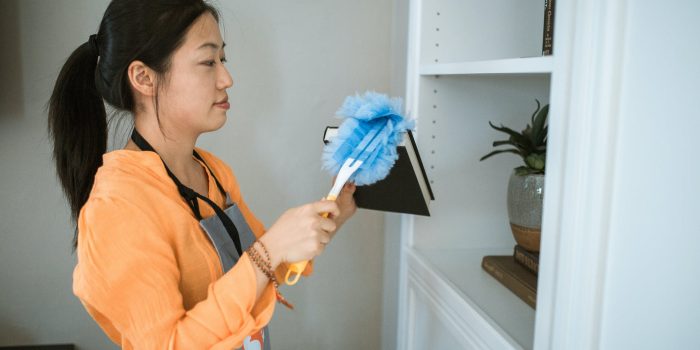The media does a good job of representing maids, and the very first image that comes to mind is a woman in a French maid outfit with a feather duster. We have bad news for you: the feather duster isn’t an effective cleaning tool.
Most professional cleaners agree that feather dusters make a lot more work instead of cleaning a house. You can even ask the nice people at Maid2Clean if this is true. However, using a feather duster has its advantages:
- Feather dusters are designed to reach weirdly shaped spaces
- Feather dusters act like bendy toothbrushes
- The feathers are extremely pliable and will even reach tight spaces.
- They’re ideal for extremely fragile items (e.g. paintings, wirework art, etc)
So we’ve got the good reasons listed down. Isn’t this enough to end the discussion? Unfortunately, no. There are far more reasons not to use this age-old cleaning tool.
1. It scatters dust.
And this is exactly the reason why professional cleaning services don’t equip their staff with this tool. It’s a disaster and becomes a health hazard for individuals who have allergic rhinitis. Instead of actually picking up dust, it disturbs dust and dirt settled on surfaces and sends it into the air. Sure, you’ve cleaned the surfaces, but you just sent the dirt floating around.
What professionals recommend: Use a feather duster for some light cleaning and open the windows whenever using the duster. Use the duster as a last resort when a wet cloth won’t reach tight spaces.
2. It doesn’t pick up dust effectively.
While the structure of a feather is ideal in capturing dust particles, it has a threshold. The layer of dust that covers the feathers won’t pick up additional dust. You’d bring it outside and shake the dirt loose. What’s worse is that the draft that enters the house will pick up the dust and scatter it again.
What professionals recommend: Use feather dusters as the last cleaning tool after you’ve wiped surfaces. This way, the feather duster won’t reach the dust threshold, making it more effective. Use a small or handheld vacuum over sectionals, mattresses, and other types of furniture with upholstery.
3. A feather duster can become a source of dust.
When the feather duster gets old, and by this we mean weeks of heavy use, the feathers that fall off become annoying. When feathers get old, it loses the rigidity present in the small blades. Yes, even though feather dusters make use of soft down, at a microscopic level, the strands are individual blades. These will start to break off and will scatter. This cleaning tool becomes a source of dirt.
What professionals recommend: Throw away feather dusters that leave feathers very clean. Use artificial feather dusters instead as these don’t break off easily. The tradeoff: natural feather dusters pick up dust more effectively than their artificial counterparts.
4. Feather dusters create dust-magnet surfaces.
Depending on the surface you’re cleaning, using a feather duster might actually make them even dirtier. The interaction of a feather duster gliding across a smooth surface will create static electricity. The surface of the object will then attract free floating dust, and the object will become dirtier than it was in the first place.
What professionals recommend: Use wet wipes on plastic surfaces, smooth wood surfaces, or generally any surface that can potentially become charged with static electricity. The best way to go about it would be to use a wet cloth. If cleaning with a feather duster, make sure to use a top-down approach, cleaning from the cleanest to the dirtiest areas to avoid dust redistribution.
5. Feather dusters aren’t animal-friendly.
Manufacturing feather dusters require specific types of birds to be used. Ostrich feathers are commonly used for feather dusters. While most companies use molted feathers to reduce wastage, these don’t work as well as feathers plucked straight from the birds themselves. The result? Better feather dusters mean hurting more birds in the process.
Now you know why you shouldn’t be using a feather duster, it’s time to list down some alternatives. Better tools for replacing your feather duster include a wet cloth, handheld vacuums, floor mops, floor vacuums, and bendy brushes. Each of these has a very specific purpose and will work better in picking up dust and dirt.


